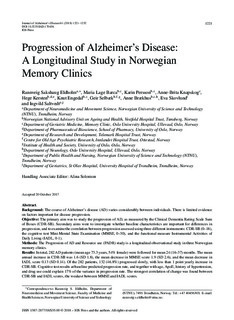| dc.contributor.author | Eldholm, Rannveig Sakshaug | |
| dc.contributor.author | Barca, Maria Lage | |
| dc.contributor.author | Persson, Karin | |
| dc.contributor.author | Knapskog, Anne-Brita | |
| dc.contributor.author | Kersten, Hege | |
| dc.contributor.author | Engedal, Knut | |
| dc.contributor.author | Selbæk, Geir | |
| dc.contributor.author | Brækhus, Anne | |
| dc.contributor.author | Skovlund, Eva | |
| dc.contributor.author | Saltvedt, Ingvild | |
| dc.date.accessioned | 2018-05-08T06:39:00Z | |
| dc.date.available | 2018-05-08T06:39:00Z | |
| dc.date.created | 2018-01-02T14:12:15Z | |
| dc.date.issued | 2017 | |
| dc.identifier.citation | Journal of Alzheimer's Disease. 2017, 61 (3), 1221-1232. | nb_NO |
| dc.identifier.issn | 1387-2877 | |
| dc.identifier.uri | http://hdl.handle.net/11250/2497423 | |
| dc.description.abstract | Background:
The course of Alzheimer’s disease (AD) varies considerably between individuals. There is limited evidence on factors important for disease progression.
Objective:
The primary aim was to study the progression of AD, as measured by the Clinical Dementia Rating Scale Sum of Boxes (CDR-SB). Secondary aims were to investigate whether baseline characteristics are important for differences in progression, and to examine the correlation between progression assessed using three different instruments: CDR-SB (0–18), the cognitive test Mini-Mental State Examination (MMSE, 0–30), and the functional measure Instrumental Activities of Daily Living (IADL, 0-1).
Methods:
The Progression of AD and Resource use (PADR) study is a longitudinal observational study in three Norwegian memory clinics.
Results:
In total, 282 AD patients (mean age 73.3 years, 54% female) were followed for mean 24 (16–37) months. The mean annual increase in CDR-SB was 1.6 (SD 1.8), the mean decrease in MMSE score 1.9 (SD 2.6), and the mean decrease in IADL score 0.13 (SD 0.14). Of the 282 patients, 132 (46.8%) progressed slowly, with less than 1 point yearly increase in CDR-SB. Cognitive test results at baseline predicted progression rate, and together with age, ApoE, history of hypertension, and drug use could explain 17% of the variance in progression rate. The strongest correlation of change was found between CDR-SB and IADL scores, the weakest between MMSE and IADL scores.
Conclusion:
Progression rate varied considerably among AD patients; about half of the patients progressed slowly. Cognitive test results at baseline were predictors of progression rate. | nb_NO |
| dc.language.iso | eng | nb_NO |
| dc.publisher | IOS Press | nb_NO |
| dc.subject | Demens | nb_NO |
| dc.subject | Dementia | nb_NO |
| dc.subject | Alzheimers sykdom | nb_NO |
| dc.subject | Alzheimer's disease | nb_NO |
| dc.title | Progression of Alzheimer's Disease: A Longitudinal Study in Norwegian Memory Clinics | nb_NO |
| dc.type | Journal article | nb_NO |
| dc.type | Peer reviewed | nb_NO |
| dc.description.version | publishedVersion | nb_NO |
| dc.subject.nsi | VDP::Klinisk medisinske fag: 750 | nb_NO |
| dc.subject.nsi | VDP::Clinical medical sciences: 750 | nb_NO |
| dc.source.pagenumber | 1221-1232 | nb_NO |
| dc.source.volume | 61 | nb_NO |
| dc.source.journal | Journal of Alzheimer's Disease | nb_NO |
| dc.source.issue | 3 | nb_NO |
| dc.identifier.doi | 10.3233/JAD-170436 | |
| dc.identifier.cristin | 1533856 | |
| dc.description.localcode | © 2018 – IOS Press and the authors. All rights reserved. | nb_NO |
| cristin.unitcode | 194,65,30,0 | |
| cristin.unitcode | 194,65,20,0 | |
| cristin.unitname | Institutt for nevromedisin og bevegelsesvitenskap | |
| cristin.unitname | Institutt for samfunnsmedisin og sykepleie | |
| cristin.ispublished | true | |
| cristin.fulltext | original | |
| cristin.qualitycode | 1 | |
